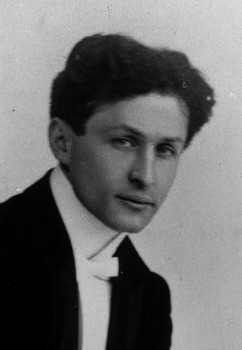The Mysterious Life of Houdini: A Magician’s Secrets Revealed
Houdini Immortalized Through Films, Photographs and Paintings at the Jewish Museum’s Newest Exhibit
July 23, 2011
Published: November 18, 2010
Have you ever tried to get out of a straitjacket? It’s frustratingly hard. In fact, the idea is daunting to most before even giving it a try. But archival footage of magician and escape artist Harry Houdini showing his escape from one while hung upside down, 50 feet above 80,000 spectators, makes it seem like mere child’s play. For one of the greatest and most mysterious celebrities of the late 19th and early 20th centuries, it was.

This footage along with a number of photographs, films and paintings inspired by Houdini are currently being shown at the Jewish Museum’s “Houdini: Art and Magic,” a showcase of the life and times of the famous magician.
The exhibit evokes the dimly lit vaudevillian atmosphere of a roadside circus tent in the Midwest. Colorful advertisements litter the walls as if Houdini should make an in-museum appearance. Many of the advertisements are works of art themselves, with carefully drawn illustrations of the magician escaping from chains and locks or contorting his body in a number of odd ways. One ad warns, “Do not confuse Houdini with any other so called Handcuff King. He is the originator of the act. All others are poor imitators.”
To look at Houdini in the many black and white photographs around the exhibit is to look at the American dream incarnate. From his early days as Ehrich Weiss, the son of a rabbi in Budapest, Hungary to performing gymnastics in backyard shows in rural Appleton, Wisconsin to catching his big break in New York and traversing the world, the exhibit shows Houdini’s trials and tribulations like an open story book. Other snapshots and footage document his duels with handcuffs, his struggle with the straitjacket and his knack for swallowing needles.
Unfortunately, Houdini’s history is much more intriguing than most of the art featured in the exhibit, which is boring and, at times, a little bizarre. Artist Matthew Barney’s “Ehrich Weiss Suite” features Jacobin carrier pigeons flying around and defecating on top of what is supposed to be a coffin in the middle of a hotel-styled room. Barney’s piece aims to comment on “the brevity of life and the dissolution with fame.” Whatever you say, Barney. While the display and others like it are creative and eye catching, they distract from the story of Houdini’s life and legacy.
More intriguing is the display of Houdini’s actual tricks. In a glass window, one can find the actual thread and needles used by Houdini in his “East Indian Needle Trick,” in which the magician would appear to swallow a number of sewing needles and a piece of string, only to pull the string out seconds later with the sewing needles attached to it. Also on display is Houdini’s cargo crate used in his “Metamorphosis” trick, a devilishly clever illusion that portrayed the magician changing into his wife and assistant, Bess, in three seconds. Unfortunately, the closed crate blandly sits on the table with no chance of the visitor exploring the interior.
Houdini’s Chinese water torture tank is also featured, in which the magician attempted an underwater escape, upside down, with his ankles shackled together and his hands cuffed. As with many magicians, Houdini’s skeptics always had something to say about the legitimacy of his dazzling escapes, so he offered $1000 to anyone who could prove that he was being fed air from the inside. Of course, nobody ever could get that $1000.
Alongside Houdini the magician, the exhibit also gives visitors a glimpse of Houdini the celebrity and Houdini the family man. Archival photographs demonstrate his versatility as he was continuously thrown into the public eye yet never forgot his humble origins. The text plastered to the walls is satisfying to read, providing the visitor with an interesting narrative of Houdini’s life. The text keeps you reading, but also makes you want to stop with anticipation in order to move on and see the next artifact or footage.
Houdini’s demonstrations were not just for show but to prove a point: break free from the chains that bind you and the world is yours. As cliché as that may sound, it was the hopeful advice for any immigrant living in America at the turn of the 20th century. The images of the magician breaking out of locks, chains and handcuffs acted as an allegory for the many immigrant fans that looked on, surrounded by a world that rejected them. In a time where anti-immigration was one of the leading sentiments in America, Houdini was the exception. 80,000 white Anglophiles didn’t just show up to his demonstrations for the hell of it; they admired him.
Finally, the exhibit shows Houdini as an established man—a crusader who fought against the falseness of Spiritualism, proving that talking to ghosts was a hoax; a captivating figure who starred and was later portrayed in movies like “Houdini” starring Tony Curtis; and a friend to an impressive, diverse crowd of famous faces like Theodore Roosevelt, Sara Bernhardt and Charlie Chaplin. By the end of his life, he was everywhere. “Houdini: Art and Magic” shows how the iconic magician, perhaps America’s first celebrity golden boy, remains a force in pop culture and our imaginations even today.











